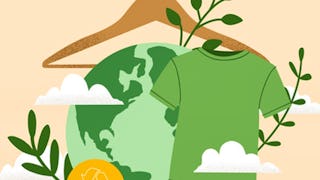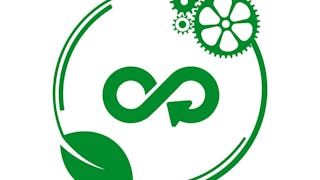The Circular Economy is about zero waste, where products are disassembled into their constituent components, either to be recycled or composted. While considerable attention has focused on the product itself, a product can only be sustainable or circular if the packaging it comes in is also sustainable and circular. This second course in the “Sustainable and Circular Product Development” specialization provides an overview of packaging today, and how it is evolving to become more sustainable. Topics include defining sustainable and circular packaging, packaging as a system, design and functionality, conventional and innovative packaging materials, advances in recycling technologies, and rethinking our approach to packaging.


Profitez d'une croissance illimitée avec un an de Coursera Plus pour 199 $ (régulièrement 399 $). Économisez maintenant.

Packaging Design for the Circular Economy
Ce cours fait partie de Spécialisation Sustainable and Circular Product Development

Instructeur : Michael J. Readey, Ph.D.
Inclus avec
(10 avis)
Expérience recommandée
Ce que vous apprendrez
Make informed purchasing decisions by identifying sustainable and circular attributes of packaging.
Explain the importance and function of packaging.
Describe how packaging is designed and tested.
Explain different packaging materials, from paper to plastic, and the innovative technologies on the horizon.
Compétences que vous acquerrez
- Catégorie : Materials science
- Catégorie : Waste Minimization
- Catégorie : Sustainable Business
- Catégorie : Environmental Regulations
- Catégorie : Sustainable Engineering
- Catégorie : Corporate Sustainability
- Catégorie : Logistics
- Catégorie : Innovation
- Catégorie : Manufacturing Processes
- Catégorie : Consumer Behaviour
- Catégorie : Sustainable Design
- Catégorie : Packaging and Labeling
Détails à connaître

Ajouter à votre profil LinkedIn
19 devoirs
Découvrez comment les employés des entreprises prestigieuses maîtrisent des compétences recherchées

Élaborez votre expertise du sujet
- Apprenez de nouveaux concepts auprès d'experts du secteur
- Acquérez une compréhension de base d'un sujet ou d'un outil
- Développez des compétences professionnelles avec des projets pratiques
- Obtenez un certificat professionnel partageable

Il y a 5 modules dans ce cours
The module begins with an overview of packaging fundamentals, such as what packaging is and why we need it. We then discuss the challenges with packaging, from the amount of packaging that ends up in the landfill to the particular challenges with plastic packaging. The module explains the many functions of packaging, from protection and preservation to communication and sustainability. Finally, the module examines packaging as a system, including primary, secondary and tertiary packaging, as well as how labels play an important role in communication and logistics.
Inclus
9 vidéos6 lectures4 devoirs1 sujet de discussion
Economic growth around the world will lead to greater consumption of stuff, and all that stuff will come packaged in one form or another. In this module, we discuss the 3 pillars of sustainability: People-Planet-Profits, otherwise known as the Triple Bottom Line, and how it relates to packaging. We introduce the concept of the Circular Economy, and its primary tenet that nothing is considered waste - including packaging. We then explore current consumer trends that prefer sustainable and circular packaging, and our collective dislike of plastic packaging. And industry is responding, with innovative approaches to both design and materials. We wrap-up this module examining how we can get from where we are today, to where we need to be tomorrow, highlighting the different approaches to making our packaging more sustainable and circular.
Inclus
8 vidéos2 lectures4 devoirs
The principles of the Circular Economy apply to packaging as much as they do to product design. In this module, we discuss packaging design from a packaging engineer's perspective, and the many elements they must consider to ensure the packaging meets business, customer and regulatory requirements. We then go deeper into those elements, including protection, material use, and user-friendliness, to name a few. To understand how these work in practice, several examples are highlighted from companies such as Ikea, Amazon and Puma. Finally, we examine the tools packaging professionals use to design packaging, such as CAD, VR and AR, and the tests used to validate packaging, such as crush tests, drop tests, and atmospheric conditioning. This module lays the groundwork for more sustainable circular packaging design, covered in the next few modules.
Inclus
8 vidéos5 lectures5 devoirs
Packaging design relies heavily on material properties to protect the product from structural damage, light and UV damage, as well as intrusion (or leakage) of gases such as oxygen or ethylene. Packaging materials have come a long way, but not necessarily with sustainability in mind. In this module, we explore the mix of packaging materials today, including paper, paperboard and cardboard, glass, aluminum and plastics. We go into each in some detail, highlighting what they are, how they are made, and where the materials are heading in terms of sustainability and circularity.
Inclus
9 vidéos5 lectures4 devoirs
Many businesses and consumers are now fully aware of the adverse environmental impacts of packaging. Yet as we often try to do in this course, those challenges create the opportunities for change. In this module, we highlight the innovations occurring in packaging materials, how reuse is possible, and conclude with examples of creative entrepreneurs rethinking packaging altogether. The module begins with advances in biopolymers and bioplastics, highlighting the many exciting advances in the field. There are also several earth-friendly packaging materials on the horizon, including those made from mushrooms and seaweed. Innovation goes beyond materials to business models, where true circularity is achieved by reusing packaging, led by a company that designed robust packaging envelopes suitable for reuse, but also the reverse logistics process to ensure they are reused. The module then introduces several designers reexamining the relationship between product and packaging, and ultimately making both more sustainable. Finally the course wraps up with an optimistic view of the potential for more sustainable and circular packaging, the people and organizations leading the way, and what we can do to accelerate the transition.
Inclus
6 vidéos5 lectures2 devoirs
Obtenez un certificat professionnel
Ajoutez ce titre à votre profil LinkedIn, à votre curriculum vitae ou à votre CV. Partagez-le sur les médias sociaux et dans votre évaluation des performances.
Préparer un diplôme
Ce site cours fait partie du (des) programme(s) diplômant(s) suivant(s) proposé(s) par University of Colorado Boulder. Si vous êtes admis et que vous vous inscrivez, les cours que vous avez suivis peuvent compter pour l'apprentissage de votre diplôme et vos progrès peuvent être transférés avec vous.¹
Instructeur

En savoir plus sur Environmental Science and Sustainability

University of Colorado Boulder

University of Colorado Boulder
Pour quelles raisons les étudiants sur Coursera nous choisissent-ils pour leur carrière ?





Ouvrez de nouvelles portes avec Coursera Plus
Accès illimité à 10,000+ cours de niveau international, projets pratiques et programmes de certification prêts à l'emploi - tous inclus dans votre abonnement.
Faites progresser votre carrière avec un diplôme en ligne
Obtenez un diplôme auprès d’universités de renommée mondiale - 100 % en ligne
Rejoignez plus de 3 400 entreprises mondiales qui ont choisi Coursera pour les affaires
Améliorez les compétences de vos employés pour exceller dans l’économie numérique
Foire Aux Questions
To access the course materials, assignments and to earn a Certificate, you will need to purchase the Certificate experience when you enroll in a course. You can try a Free Trial instead, or apply for Financial Aid. The course may offer 'Full Course, No Certificate' instead. This option lets you see all course materials, submit required assessments, and get a final grade. This also means that you will not be able to purchase a Certificate experience.
When you enroll in the course, you get access to all of the courses in the Specialization, and you earn a certificate when you complete the work. Your electronic Certificate will be added to your Accomplishments page - from there, you can print your Certificate or add it to your LinkedIn profile.
Yes. In select learning programs, you can apply for financial aid or a scholarship if you can’t afford the enrollment fee. If fin aid or scholarship is available for your learning program selection, you’ll find a link to apply on the description page.
Plus de questions
Aide financière disponible,



